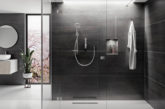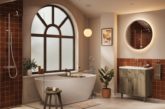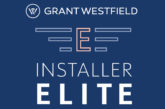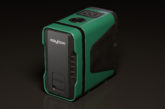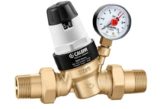
Backflow presents challenges and risk for commercial and public use buildings, but Reduced Pressure Zone (RPZ) valves provide an easy and reliable solution. Richard Bateman, Product Marketing Manager at RWC, looks at the legislation and the technology.
As all plumbers know, backflow is when stagnant or contaminated water gets sucked back into the mains water supply. There are two main causes, again well known – back-pressure or back-siphonage, which occurs when water is pushed in the opposite direction to its standard flow path.
Back siphonage can occur if there is a sudden drop in pressure upstream of an outlet – for example from a burst pipe – causing the contents of the pipework to drain towards its source.
In the event an outlet is open when back siphonage occurs – for example a garden hose being left to fill a pond – harmful contaminants could be pulled back into the potable water supply. There are many other appliances – for example baths, showers, washing machines, even swimming pools that are potentially a backflow or back siphonage risk. Ensuring the correct level of prevention or protection is in place is key.
Battling backflow with regulations
To help tackle the problem of backflow, the Water Supply (Water Fittings) Regulations (1999) for England and Wales (Byelaws in Scotland) have identified five fluid categories, each representing a higher degree of risk. Fluid Category 1 is considered safe, while Fluid Category 5 presents a very serious health hazard. These categories are important, and we’ll look at them in more detail shortly.
The presence of contaminants in clean water presents a real and immediate risk to health. This is never good for any building, but it’s especially concerning in hotels, schools and hospitals and healthcare facilities. In these spaces, occupancy is high, the system is in constant use, and potentially vulnerable or at-risk users may be using the system.
There’s also the potential for this backflow to enter the mains water supply, posing a wider public health risk to neighbouring homes and communities. In extreme cases, building owners can face prosecution. Moreover, the process of draining and cleaning water supplies results in significant disruption and water waste, with all the sustainability implications that brings.
As the regulations were introduced in 1999, backflow prevention is of particular importance to refurbishment projects and heritage buildings.
The five fluid categories
The key to navigating backflow regulations is understanding the expected level of fluid risk for the building in question, and what level of protection will be needed.
Fluid category 1 and 2
Fluid category 1 – ‘wholesome water’ which complies with section 67 of the Water Industry Act 1991 – requires no specific countermeasures or action. Fluid category 2 covers water which has altered in either appearance or taste, with likely causes being either a temperature change or the presence of micro-organisms or other substances. Here, a single check valve will suffice.
An example of this is a basin mixer tap, where hot water can sometimes pass back into the cold supply – installing a single check valve to the cold pipe feeding the tap would prevent cross flow from occurring.
Fluid category 3
Fluid category 3 represents water with low levels of toxicity which nevertheless present a slight health hazard. In these cases, double check valves must be installed. One instance of this would be a supply to an outside tap – unless this supply is feeding a sprinkler system that uses pesticides, in which case higher protection is required.
The valve you choose must be compliant with the Water Supply Regulations 1999. Part of RWC’s family of brands, the JG Speedfit range of plastic push-fit fittings offers a Double Check Valve with a Stop Valve. The stop valve isolates the water supply to the outlet, for installers to easily service the outlet that the valve is connected to instead of needing to shut off the whole building’s water supply.
Fluid category 4
The more significant health hazards begin with Fluid category 4, which is water with harmful concentrations of toxic substances. Suitable backflow prevention devices are required in these situations, such as RPZ valves. Reliance Valves’ Reduced Pressure Zone (RPZ) Valve, for example, is a safe and reliable backflow preventer available for commercial (fluid category 4 risk) applications.
This device is a verifiable assembly, that is designed to be regularly tested, to ensure the higher risk of potential contamination is limited. In the event of a drop in pressure or back siphonage occurring, the mains water supply is protected by diverting the back-fed water from a property out to a waste pipe, therefore diverting it from the main supply and drinking network, limiting the risk of contamination. Applications include commercial dishwashers and cleaning appliances, commercial heating systems and fire sprinkler systems where anti-freeze is not used.
Fluid category 5
The highest risk level of all – Fluid category 5 – represents the most serious health hazard because of the presence of pathogens and radioactive or very toxic substances. Fluid category 5 is a highly specialist area calling for a Class 5 backflow prevention device, incorporating a Type AB air gap or equivalent.
Ensuring a safe environment through maintenance
When we move into the high risk fluid categories, i.e. categories 4 and 5, this is where maintenance becomes critical to ensure they work correctly. While RPZ valves are highly effective, they need to be installed, commissioned and tested by an approved RPZ Valve Tester, who must notify the water authorities of the status of all works.
Equally, because of their vital function, they need to be regularly tested – again by an approved installer. It is a legal requirement that this test is conducted every 12 months to ensure that it is operating correctly and doesn’t require further maintenance. The exact schedules will vary across local water undertakers, but full guidance can be found on their websites.
Backflow presents significant risk. However, there are easy and efficient ways to prevent it from happening, and to ensure an uninterrupted supply of safe clean water.






